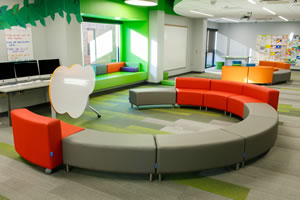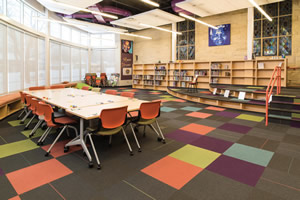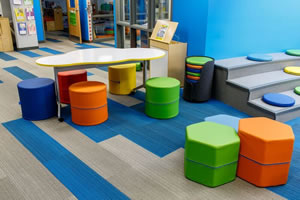Specifier's Report: Outfitting 21st-Century Educational Facilities

Photo courtesy of NorvaNivel
When it comes to product specifying and the subsequent purchasing process, the number-one thing to know is that one size does not fit all. Rather, the process varies from district to district and state to state, depending on district size, board policy, state requirements, and federal requirements.
District size: Small school districts may not have a purchasing department. Instead, purchasing may be one of many hats that different administrators wear, such as the facilities department ordering replacement HVAC units and the technology services department ordering new printers. And purchasing procedures may be less formal than in large districts, which may have structured purchasing departments in which agents review requests to ensure that they meet policies, the budget is available, and all the paperwork is in order.
The bottom line, as David Bein, SFO, assistant superintendent of Business Services/CSBO for Barrington Community Unit School District (CUSD) 220 in Illinois, notes is that, “Even in any given state, districts of comparable size may do many things similarly, but some things may be different. Not every school district does things the same.” The suburban Chicago district, which has nearly 9,000 students in grades Prek-12, has an annual operating budget of $165 million.
Board policy: “School boards adopt policies to govern the administration of the district, and that’s followed with administrative procedures to implement board policy,” says Bein. One chunk of board policy focuses on product specification and purchasing, including when quotes are required and when the board must approve a purchase, which varies from board to board. As the Ohio School Boards Association (www.ohioschoolboards.org) states, “Board policies may require obtaining quotes for some … purchases even though the law does not require competitive bidding.”
Kristofer Upson, PE, MBA, executive director of Operations for Salina USD 305 in Kansas, explains how it’s done in his district: “Our board gets to see purchases made between $10,000 and $20,000. They don’t approve them, but they see them. Anything over $20,000 has to have board approval and, generally speaking, it has to be bid out, unless we use a blanket purchase agreement.” With an annual operating budget of $141 million and 7,000 students, Salina USD 305 is the 10th largest in the state.
In the spirit of transparency and open communication, Matthew Helgerson, superintendent of Jordan Public Schools in Minnesota, seeks board approval for things that are not part of the normal day-to-day operations, regardless of the dollar amount. “We have 2,000 students in a community of 7,000 people,” he says. “I don’t want board members or the community to be in the dark about anything,” he admits. “It builds positive relationships; it builds trust.” The district’s operating budget for Fund 01 is more than $20 million.
State requirements: Not surprisingly, with 50 states, there are 50 different policies regarding public bid requirements. In Illinois, there is a requirement to publicly bid purchases of a certain size. “There’s a threshold at $25,000 for supplies/materials and a number of other things,” says Bein. “It changes to $50,000 for facilities repairs/maintenance, such as HVAC replacement. Then there are a set of bidding exceptions for higher-level services, such as legal services and accounting services.” In contrast, in Ohio, competitive bids are required “to ‘build, repair, enlarge, improve or demolish any school building’ if the cost of the work is over $50,000 (Ohio Revised Code (RC) 3313.46)” and for “any contracts for the purchase of school buses (RC 3313.172, 3327.08),” according to Ohio School Boards Association.
Federal requirements: Federal regulations add another layer of complexity to the specifying and purchasing process. Ohio School Boards Association notes two occasions when federal law stipulates that competitive bids must be obtained. The first is “if the cost is over $150,000,” and the second is for “purchases over the simplified acquisition threshold of $150,000 when using federal grant funds.”

PHOTO COURTESY OF J+J FLOORING
ADVICE FROM THE EXPERTS
In spite of the endless number of ways that school districts can structure purchasing and the vast amount of regulations that must be taken into account, purchasing is successfully managed every day in public and private schools across the country. And, because of that, administrators have plenty of advice to share to make it a bit easier.
Specify the product that solves the problem. Again and again, the experts say that it’s critical to purchase the product that solves the problem first, and is durable and easy to maintain, second and third. Here are additional nuggets of information that help flesh out this advice.
Salum Stutzer, director of Facilities/Purchasing for Independence School District in Missouri, notes that solving the problem means matching the product to the program function and intent for the area in which the product will be placed. “In solving the problem, you can select the Cadillac, middle-of-the-road or lower-end product,” he says. “There’s a happy medium in there and, for us, it’s trying to get the best bang for our buck by choosing products that have a good life span, are easy to clean, easy for our technicians to maintain, and of which our technicians are certified to maintain.” His department has an annual operating budget of $17 million and, with more than 15,000 students, the district is the 13th largest in the state.
Bein indicates that solving the problem is about being intentional about understanding what you need. For example, if you need to order rulers, should they have imperial or metric markings? Should they be solid wood or clear plastic?
Upson takes Bein’s advice a step further, noting that, while your architect may be making specifications, it’s up to you to know about those products. “You have to dig in there and find out what’s what so you don’t get what you didn’t want,” he says. “Make it a collaborative process with those stakeholders who have skin in the game. Also, rather than specifying one product only, indicate that this brand or that brand will work so that bidders have an option for pricing.”
Seek help when you’re not sure what product will solve the problem. One way to seek help when you’re not sure what product will solve the problem is reaching out to colleagues. “Develop relationships, and ask questions,” says Helgerson. “Ask colleagues at other districts for help. We don’t do that enough. I’m lucky to be in an area where superintendents are willing to ask and share information, and that’s the greatest resource.”
Another way to seek help is by talking with vendors. That’s what Suzie Pearson, principal of Wallace Elementary in Johnston, Iowa, did. “Our focus was moving from a teacher-directed to a student-centered environment,” she notes, describing how the school recently underwent a transformation from a middle school to an elementary school serving 400 preschoolers and 650 K-5 students (with a capacity for 800-plus K-5 students). She spent a lot of time talking with numerous furniture manufacturers to find product that met her definition of a student-centered environment. “We could choose desks or tables,” she recalls, “and, while they could be configured in different ways, at the end of the day, they were still desks or tables.”
Finally, at a conference, Pearson found NorvaNivel, a Dallas-based furniture manufacturer that focuses on creating product for “flexible, agile, and collaborative learning environments” (norvanivel.com) and learned that the company, along with ELB (www.elbeducation.com), was willing to work with her team to alter classroom design to more closely meet student and educator needs. As one example, the company has a teacher station wherein the top could be lifted so that items could be stored beneath. “We asked if they could change it from a lift top to a drawer,” she says. “They were willing to take our ideas and suggestions and implement them to meet our needs. We wanted that. We didn’t want to buy product that didn’t meet our needs.”
Pearson is now working with other administrators in the Johnston Community School District, which serves approximately 7,400 students with general fund budget of $85 million, according to its website (www.johnstoncsd.org), to transform its other schools to student-centered environments.

Photo courtesy of NorvaNivel
Keep building those relationships: Relationships are key to specifying the right product. Helgerson says that, after trying to save money in the past by doing things inhouse only to later learn that those things did not meet code, he now works with an architect. This relationship has been especially helpful as the district has been converting operating systems such as boilers, chillers, and HVAC controls in the last five years. “We meet with our contact, do an assessment, talk about problems we’re incurring and share our goals, he explains. “The architect helps with specifications to ensure we meet building code and budget requirements, and solve the problem we want to solve.”
Be willing to make changes: New products are continually being introduced. Some are valid options, some are not. Existing products are continually being improved upon, some for the better, some not. With this in mind, it’s important to be willing to make changes when replacing worn out products and renovating existing facilities. This is true even if it means that you end up changing a standardized product.
In recent years, Upson has worked to make changes, with the goal of purchasing products that require less maintenance and/or last longer than what was previously specified. One example is a change in roofing retrofits from modified bitumen to TPO to PCV membranes. “I believe this evolution is giving us the best value and best life span,” he explains. He has also moved from sheet tile to carpet tile, which is low-maintenance and easy to replace.
It’s clear that there’s a lot to take into consideration when specifying the right product for your school or district, which may be a source of frustration. Following the experts’ recommendations to search for the product that solves the problem, seek help when it’s needed, build relationships and be willing to make changes may ease that frustration.
This article originally appeared in the School Planning & Management April/May 2019 issue of Spaces4Learning.